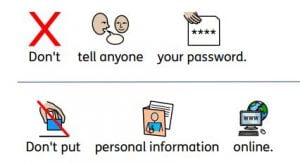Regardless of age, ability or learning needs, the essentials of online safety remain consistent: look after your personal information; be sure you know who real ‘friends’ are; don’t meet anyone offline you first met online; and tell an adult if something concerns you. However, the media we use to convey these messages needs to be varied in order to put them across to audiences with the whole range of special educational needs and disabilities (SEND).
In some instances this can be straightforward. For example, Thinkuknow have produced a couple of videos specifically for older pupils – teenagers – whose first language is British Sign Language (BSL). These are well  made, with age appropriate content, and using deaf, adolescent, actors that the intended audience can relate to. In fact, although there is no spoken dialogue, the use of sub-titles means that videos such as Sam’s Real Friends could be used inclusively with wider school groups. But this is a very specific cohort, with a clear learning need – materials in their first language, BSL.
made, with age appropriate content, and using deaf, adolescent, actors that the intended audience can relate to. In fact, although there is no spoken dialogue, the use of sub-titles means that videos such as Sam’s Real Friends could be used inclusively with wider school groups. But this is a very specific cohort, with a clear learning need – materials in their first language, BSL.
Other groups will need different approaches. The STAR Toolkit was developed with learners with autistic spectrum conditions (ASC) in mind, although they could be useful for learners with a wider range of needs. They address several different concerns including ‘Safe sharing,’ ‘Trust,’ ‘Action,’ and ‘Respect,’ (hence the name). However, the materials provided, PowerPoints and worksheets, will need adapting for the audience as some of the slides are quite busy, with a lot of text and some demanding language.
Widgit have also produced resources intended for learners with a wide range of challenges who may have difficulty in decoding text with materials which use their sym bol set to aid access to a number of straightforward online rules.
bol set to aid access to a number of straightforward online rules.
The Thinkuknow website also has some resources targeted at SEND learners, which can be searched for by age range in their resource library , although the results can be quite mixed. In the 4-7 age range the same videos are offered whether or not the SEND group is chosen. The content across all age groups can be quite demanding, although age appropriate for the audience, but requiring a level of understanding that those with cognitive challenges may find difficult to comprehend. One suggestion might be to use materials for a younger age group with a simpler content level, but this raises issues of age appropriateness.
 Other providers have also created materials that could, with the right level of support, be helpful, even for secondary students. Discovery Education’s video on Youtube has very direct messages using cartoon characters. Whilst these are intended for a primary audience the content is clear and the presentation is not patronising, nor talks down to its viewers. The characters whilst obviously children are not of a particular age group, so may be acceptable to older learners.
Other providers have also created materials that could, with the right level of support, be helpful, even for secondary students. Discovery Education’s video on Youtube has very direct messages using cartoon characters. Whilst these are intended for a primary audience the content is clear and the presentation is not patronising, nor talks down to its viewers. The characters whilst obviously children are not of a particular age group, so may be acceptable to older learners.
A similar way of offering content focused on young audiences offered in a way that older students might find engaging too, is to use the Disney Corporation’s  Safety Smart with Timon and Pum ba video which can be found on Youtube here. The whole video is quite long for an SEND audience, and in the balance of entertainment to education tends to favour the former, so it may need to be watched several times, stopping and starting to pick up the teaching points. There is also a shorter version. Whilst the content might need unpacking, it can prove effective, as ever yone, regardless of age, loves the Lion King so won’t mind watching the antics of two of its stars.
Safety Smart with Timon and Pum ba video which can be found on Youtube here. The whole video is quite long for an SEND audience, and in the balance of entertainment to education tends to favour the former, so it may need to be watched several times, stopping and starting to pick up the teaching points. There is also a shorter version. Whilst the content might need unpacking, it can prove effective, as ever yone, regardless of age, loves the Lion King so won’t mind watching the antics of two of its stars.
With the range and complexity of SEND, and the added layer of online safety being a subject that needs to be revisited throughout a child or young person’s time in school, the task of finding appropriate materials to engage and educate can prove challenging. But if we want them to live and to learn independently, it is a task that benefits from a bit of research.
